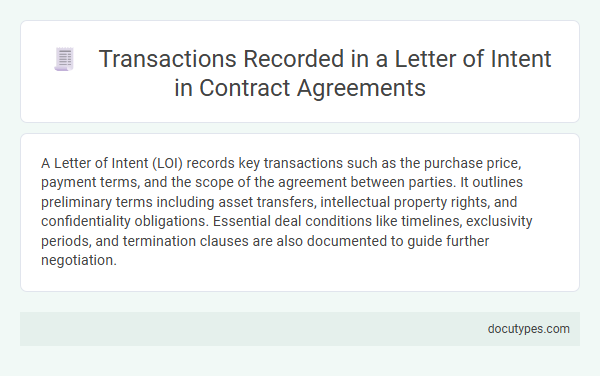A Letter of Intent (LOI) records key transactions such as the purchase price, payment terms, and the scope of the agreement between parties. It outlines preliminary terms including asset transfers, intellectual property rights, and confidentiality obligations. Essential deal conditions like timelines, exclusivity periods, and termination clauses are also documented to guide further negotiation.
Introduction to Transactions in Letters of Intent
Letters of Intent (LOIs) outline preliminary agreements between parties before finalizing a contract. They specify key transactions to ensure mutual understanding and guide subsequent negotiations.
- Asset Purchase Transactions - LOIs record agreements related to the sale or transfer of assets between parties.
- Equity Investment Transactions - These include commitments for purchasing shares or equity interests documented in the LOI.
- Service Agreements - LOIs may capture essential terms for future service engagements or partnerships.
Purpose of Recording Transactions in LOIs
A Letter of Intent (LOI) records preliminary agreements and key terms related to a potential transaction. The primary purpose is to outline the framework for negotiations and future contracts.
- Indicative Terms - Captures essential deal terms such as price, payment structure, and timelines to guide further discussions.
- Intent to Proceed - Establishes the parties' mutual intention to continue negotiating toward a definitive agreement.
- Clarification of Roles - Defines responsibilities and obligations during the negotiation and due diligence phases.
Recording these transactions in an LOI ensures clear communication and aligns expectations between parties before formal commitments.
Legal Status of Transactions in LOIs
A Letter of Intent (LOI) outlines preliminary agreements and expresses the parties' intent to enter into a contract. It records key transaction terms but often lacks enforceable commitments unless specified.
- Binding Provisions - Certain clauses in the LOI, such as confidentiality and exclusivity, may have legal enforceability depending on wording and jurisdiction.
- Non-Binding Terms - Most transaction terms in an LOI, including pricing and timelines, are usually non-binding and serve as a framework for negotiation.
- Conditional Obligations - The LOI may record conditional duties that become binding only upon execution of a definitive agreement, preserving your negotiating flexibility.
Differences Between LOIs and Binding Contracts
A Letter of Intent (LOI) records preliminary agreements such as price, transaction structure, and key obligations during negotiations. It outlines the framework without imposing full legal commitments.
Binding contracts, in contrast, include enforceable terms detailing specific rights, duties, and remedies for parties involved. You should understand that LOIs often contain non-binding provisions, while binding contracts finalize the transaction.
Key Components of Transaction Records in LOIs
A Letter of Intent (LOI) records preliminary agreements and key terms of a potential transaction between parties. It typically includes the scope of the transaction, purchase price, payment terms, and contingencies such as due diligence requirements. Essential components also cover confidentiality clauses, exclusivity periods, and timelines for finalizing the definitive agreement.
Risks Associated with LOI Transactions
A Letter of Intent (LOI) typically records preliminary agreements related to mergers, acquisitions, or major business transactions. It outlines key terms such as price, timeline, and due diligence requirements but is generally non-binding.
Risks associated with LOI transactions include potential misunderstandings about binding obligations and exposure to liability before a final contract is executed. You may face financial or strategic risks if the LOI is vague or lacks clear termination clauses. Proper legal review minimizes disputes and safeguards transactional interests.
Negotiation Strategies for Transaction Terms in LOIs
A Letter of Intent (LOI) typically records preliminary agreements on key transaction terms such as price, payment method, and timelines. These recorded terms set the foundation for the final contract, guiding the negotiation process between parties.
Negotiation strategies for transaction terms in LOIs involve clearly outlining contingencies, conditions precedent, and confidentiality clauses. You can leverage precise language to minimize misunderstandings and foster mutual commitment during deal structuring.
Enforcement of Transactions Recorded in LOIs
Transactions recorded in a Letter of Intent (LOI) typically include preliminary agreements, key terms, and conditions that outline the parties' intentions before a final contract is executed. Enforcement of these transactions depends on the specificity of the language and whether the LOI is intended to be legally binding or merely a document of mutual understanding. You must carefully review the LOI's provisions to determine which obligations are enforceable and to avoid unintended legal commitments.
Best Practices for Drafting Transaction Clauses in LOIs
| Aspect | Details |
|---|---|
| Transactions Recorded in a Letter of Intent (LOI) | LOIs typically record key transactions such as asset purchases, stock acquisitions, service agreements, joint ventures, or licensing deals. The document outlines the scope, structure, and financial terms of the intended transaction to ensure alignment between parties. |
| Purpose of Transaction Clauses | Transaction clauses define the nature of the transaction, including obligations, price mechanisms, timelines, due diligence parameters, and conditions precedent. These clauses provide a framework for negotiations and set expectations before definitive agreements. |
| Best Practices for Drafting Transaction Clauses in LOIs |
|
| Common Pitfalls to Avoid | Overly vague or broad transaction descriptions, mixing binding and non-binding clauses without clear separation, omitting key financial terms, and failing to address contingencies or termination rights. |
Which Transactions Are Recorded in a Letter of Intent? Infographic

